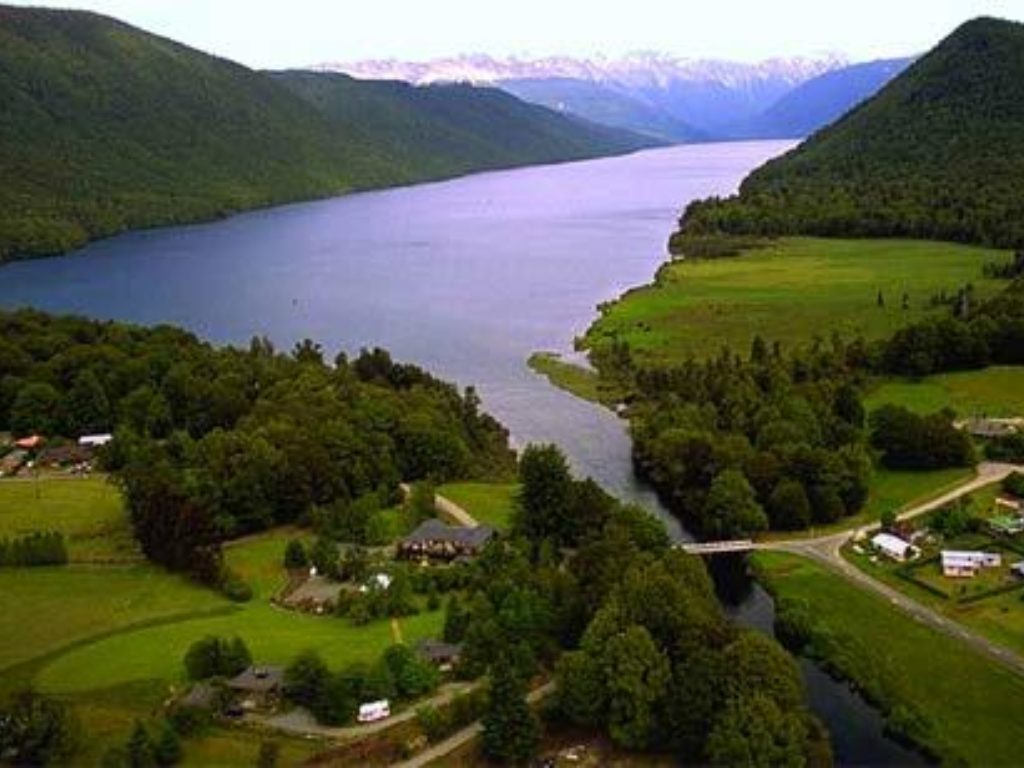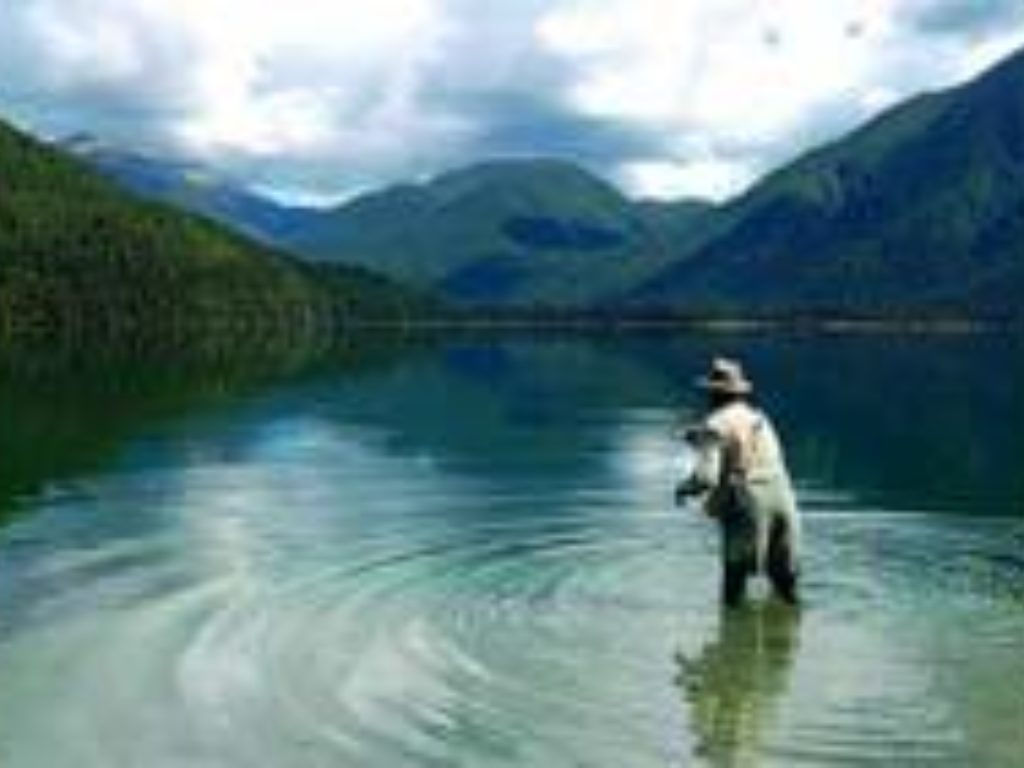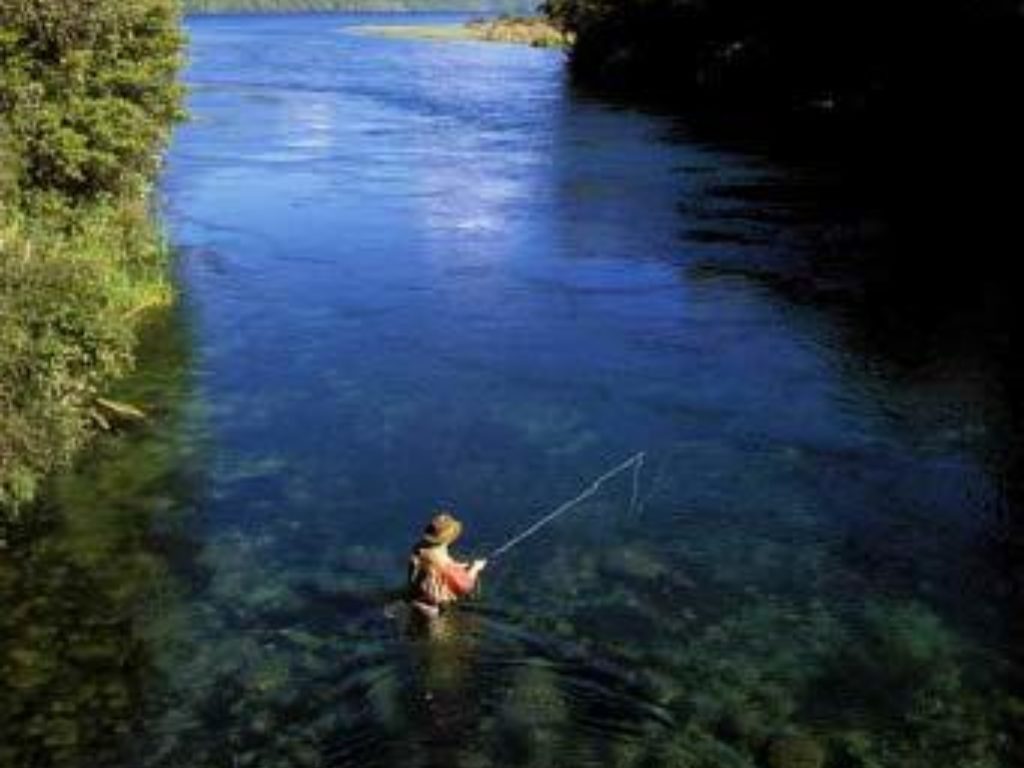Jul 26, 2017
Fishing for Browns in Paradise - New Zealand's Lake Rotoroa
James O. Fraioli, Contributing Editor
HUNKERING DOWN BESIDE A TOWERING CLUSTER of flax-palms, my felt-sole shoes dig into the sandy shore of New Zealand≠s Lake Rotoroa. Beside me hunkers David Pike, my young Kiwi guide, who watches as two German brown trout - both in the four-pound range - forage in the shallows. At my feet lies enough fly line for a cast; the small of my back tightens in anticipation. The warm sun and the whooshing of a nearby river are hypnotic, and my mind wanders across the snow-capped peaks of the Travers Mountain Range stretched out in front of us. "Put a cast three feet in front of them!" directs Pike, snapping me out of my trance. I had been reading up on and practicing my casts back home but am now faced with the ultimate test. Pike, a native of New Zealand who has fished these waters since childhood, tracks the trout through his polarized sunglasses. The trout continue to swim in lazy circles, zeroing in on anything that wrinkles the surface. I raise my right arm slowly, gently cradling the fly line in my left. Struggling for balance, I begin false-casting, hoping I don≠t spook the fish in the process. "Okay, drop it," Pike whispers. "Now wait...wait..." One of the browns spots my sinking nymph and races in. "Watch your indicator." Pike≠s voice is tense. A little piece of white fuzz tied to my line bobs motionless - then twitches. "Hit it!"
Remote Lake Rotoroa (above), 12 miles long and 460 feet deep on New Zealand≠s South Island, offers some of the best brown trout fishing in the world.
When I respond, my reel sings as the big trout peels off line. The weight at the other end of my rod causes me to laugh out loud. My first New Zealand brown!
New Zealand is one of the world≠s great angling destinations. And Lake Rotoroa, nestled at the northern tip of New Zealand≠s spectacular Southern Alps, is considered to be the crown jewel in South Island≠s Nelson Lakes National Park. Far from the madding crowd, the glacial water of this isolated and unspoiled lake feeds the area's many rivers and creeks, which support a thriving and sustainable brown trout fishery. At 12 miles long, a mile and a half wide, and 460 feet at its deepest, Lake Rotoroa is the largest lake in the park. It≠s surrounded by a mixed beech-podocarp forest that offers fishermen complete tranquility and privacy - important elements that bring guests back to the lake time and again. Famous for its clean, green environment, Lake Rotoroa and its neighboring rivers are a trout fisherman≠s paradise, offering some of the most pristine and productive locations imaginable. Travelers have always been captivated by New Zealand≠s remote beauty; after all, with just four million people in the country, there≠s a lot of room for scenery. And with one-third of its land protected by national park status, the wilderness is always close - and plenty of wilderness means plenty of fishing opportunities. One measure of any trout experience is how often one can find and catch fish. At Lake Rotoroa, and on its 40 nearby rivers, that happens a lot. The region is one of the best fly-fishing areas in New Zealand and, with the introduction of the German brown trout in the latter part of the 19th century, an international reputation has developed. Last March, I spent four days at renowned Lake Rotoroa Lodge, sampling this great brown trout fishery. During my visit, I was invited to try both lake and river fishing - and caught plenty of respectable fish in both locales. Often using the sun and cloudless sky to our advantage, my veteran guide Pike and I would walk miles of shore to sight, stalk, and cast to magnificent trout in crystal-clear waters. Sight-fishing, as it's called, is extremely popular - creeping up on a trophy brown trout really gets your adrenalin flowing.
For hours, we would scan for brownish-gray shadows, strategically position ourselves as close to the water as we could, make a full cast directly at the fish, and land dozens of hefty browns after well-fought battles. The trout ranged from four to six pounds, although fish over 10 pounds are reported every season. With so many impressive fish in the lake and rivers, it's easy to get spoiled, and, at times, I would find myself annoyed when landing a two-pounder - a memorable catch in most parts of the U.S.
The Lake Rotoroa experience includes the comforts of a traditional sportsman's lodge (above), fishing truly alone (center), and the beauty of a pristine landscape (opposite). On a couple of occasions, dark storm clouds would drift overhead and we had to rely on "blind" fishing - casting into a pocket of water that may not be holding any fish. This is when keen eyesight, polarized lenses, and quick reflexes are the difference between landing and missing a strike. Alternate guide Richard Booth would tie a piece of white lamb≠s wool - the strike indicator - above my nymph. After the cast, he instructed me to focus on the indicator, especially in fast-moving water. As soon as the indicator hesitated or stopped, I would need to set the hook. If the indicator completely disappeared, that would often mean I was too late and the trout had already inspected, tasted, and spit out my bait. At Rotoroa, nymph-fishing is the preferred method, unless trout are on the rise, when switching to a local dry fly or standard attractor pattern (like a Royal Coachman) promises a strike. The most important tip to ensure a successful fishing trip in a foreign country like New Zealand is to listen to and trust your guide. A guide is not merely a convenience or luxury but an essential. These experts have most likely studied the local waters since they were kids running home from school to go fishing. They know every hole, are able to spot a lurking shadow long before you can, and, more often than not, can guarantee plenty of action if you follow their advice. "The trout fishing in New Zealand is different" says Carmen Garcia, a chiropractor and avid fly-fishing enthusiast from Delaware. "So I always fish with a guide. There are holes that might look great but aren't holding any fish. Conversely, many of the really big trout are lying in spots where normally, back home, I wouldn't fish." After four remarkable days, I found myself exhausted, having landed dozens of prized brown trout, all of which we released unharmed.
Lake Rotoroa Lodge (above right) offers both lake and river fishing. Above left: Fishing guide David Pike shows off a freshly caught German brown. Located seven miles down a country road that winds through the Gowan River Valley, the Edwardian-style Lake Rotoroa Lodge sits in the midst of paradise. Waves from the lake gently lap at the shore and spill onto the lodge≠s front lawn. Birdlife is astounding. One morning before breakfast, I walked out to feed the black swans and paradise ducks that frolic along the shore. Later, I learned that much of New Zealand - as one of the last places on the planet to be settled by humans - features many species of flora and fauna found nowhere else on earth. From October through April, Lake Rotoroa Lodge - with its impeccable service, culinary extravaganzas, full bar, and wine cellar - is famous for bringing together trout fishermen who travel internationally to find the finest guides, best fishing, and most beautiful settings in the world
"Comfort and satisfaction is our only concern" say lodge managers Brent and Sharleen Hyde. "During your stay, you will be looked after by a friendly and dedicated team who always ensure your individual needs are known and met."
I found Lake Rotoroa to be the ideal place to get away from it all, while being surrounded by some of the finest brown trout fishing on earth. I can≠t wait to go back!
Simply spectacular: The snowcapped Travers Mountain Range (above) forms a backdrop for a fisherman casting upstream toward Lake Rotoroa.
Contact us to plan and book your NZ fly fishing adventure.


